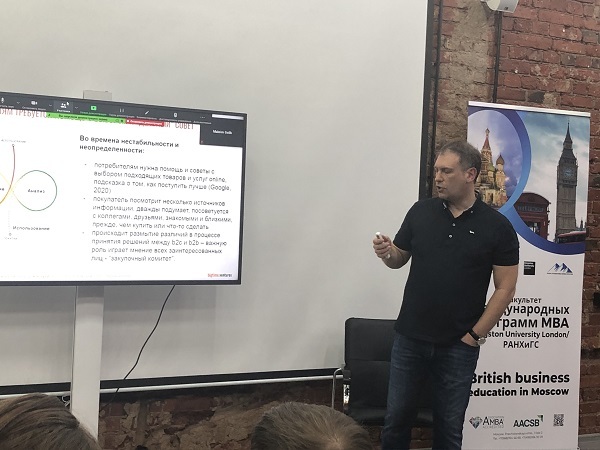As Roman Khokhlov, a student of the 1st year of EMBA, the head of an IT company, noted:
"... marketing turned out to be not what I imagined it to be. It started with strategic planning, and ended with brand management. A serious meaningful conversation instead of how to make business cards beautifully, keep leads and speak at the exhibition is my naive idea of marketing."
Alexey and Yaroslav Ivanenko talked about how marketing is changing under the influence of digital technologies at the evening master class, both of them graduated from the Kingston/RANEPA Faculty of International MBA Programs and returned to the audience as experts in digital transformation of marketing and sales, managers of Bigtime Ventures.

The school actively supports the exchange of unique management experience between the students of the program, between the programs themselves. So, continuing the conversation about marketing, Vitaly Baskin, a listener of the program, shared his experience, or rather cases and lessons learned; Advanced Management.
Vitaly is the Regional Development Director of SPLAT in China. The speech, as expected, was about how SPLAT groped its way to the minds and hearts of Chinese consumers, often through trial and error – an incredibly interesting and informative conversation.
And, of course, the master class is a cool story. This time we invited the creator of the super successful Russian brand "Masha and the Bear" to visit us. Dmitry Loveyko, co-producer and CEO of Animaccord studio, generously shared recipes for creating the so-called "evergreen brand" with the listeners of the program. "Masha and the Bear" is a multi–layered product, there are layers of humor for children, and there are for their parents – this, as we found out, is one of the signs of the "evergreen brand".

Did you know that Masha and the Bear speaks 28 languages, the animated series is registered in the Guinness Book of Records – 1% of the world's children's traffic on Youtube falls on watching Masha and the Bear, children with the name Masha have appeared in Indonesia, a festival is taking place where almost 10,000 people wear Masha and the Bear costumes, and in the Italian city of Bergamo there is a Masha Park where the cartoon comes to life - there are many such interesting facts.
Interestingly, the idea of a new project was prompted by a curious case. One of the creators of the future series was relaxing on the beach in Malibu. Here, a girl Masha played with her parents in the sandbox, a small, lively 5-year-old, she "brought up and built" everyone around, and very soon became a "legend of the beach". "The men swam from this Masha for buoys," the story says. In a certain sense, this lively girl became the prototype of a cartoon character. There is a new reading of the classic "clown couple" in a row with "Tarapunka and Plug", "Baby and Carlson", "Wolf and Hare" – "Masha and the Bear".
Important thoughts from the point of view of the business model:
- There is a division of labor in animation. Production sites are concentrated in China, India, creativity is created in France, investments are in America.
- All the artists who work on the cartoon are from the "Russian school of animation", but the team of artists is distributed.
- The company attaches great importance to IP management: the intellectual property of Masha and the Bear is registered in all countries.
- The company has a well-developed infrastructure for B2B work. The choice of partners and quality control is taken very seriously – the basement of the office is packed with industrial samples that are sent from all over the world.
- The animated series is created largely based on feedback from viewers. Posting the next series on Youtube, the creators, based on the comments, finalized the cartoon, including the appearance of the characters. Did you know that in the first series, the girl Masha was a little crooked, but the audience didn't like it? Here is such an "agile production"!
- One episode of the cartoon for 6 minutes is made for six months or a year. There are 5-6 episodes in production at the same time.
- To enter foreign markets, a high-quality translation into English is important. It is worth investing seriously in this, since the translation into Chinese, Italian and all other languages will be done from English.
There are also "soft" parameters of the business model. Here are some of them:
- Children associate Masha with themselves, she cannot be punished and put in a corner.
- The girl who first voiced Masha has already grown up, she is 16 years old, she works at the studio as a mentor of new "voices" – so the "old" Masha trains the "new" one.
- The company does not conduct cultural studies, so it is not always clear why "Masha and the Bear" is phenomenally popular in China, but in Japan the cartoon is perceived with restraint?

The participants of the master class had the impression that despite the worldwide popularity of the cartoon, business is still developing intuitively in many ways. As Dmitry Loveyko replaced: "If you seriously invest in something, give your soul to it, there will always be people who will appreciate it." It is impossible not to agree!





